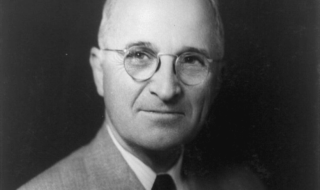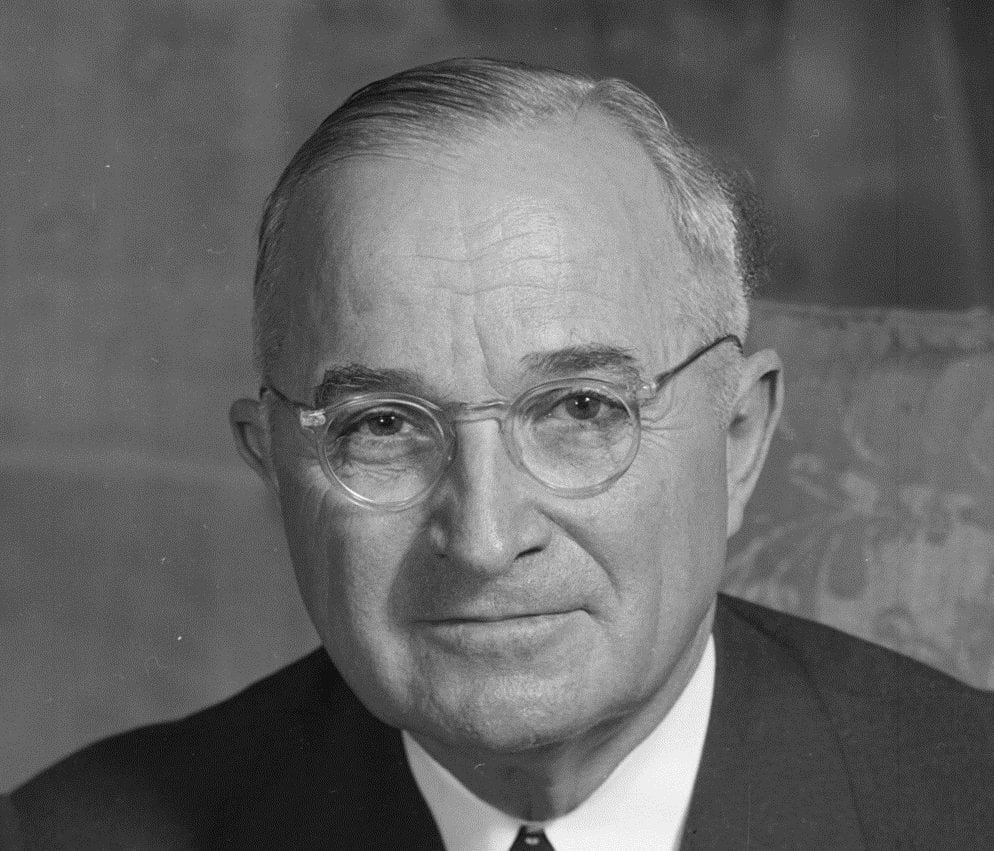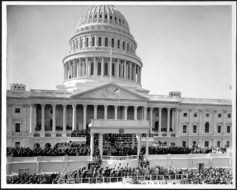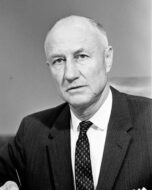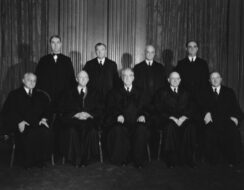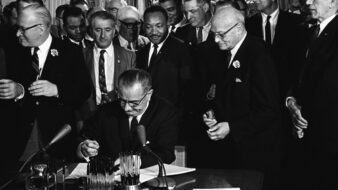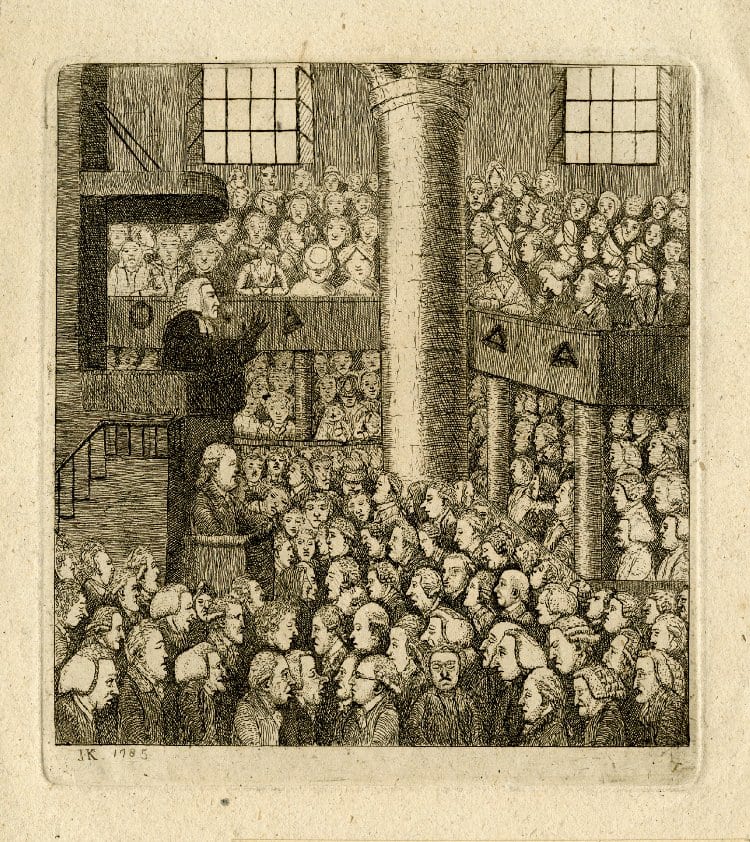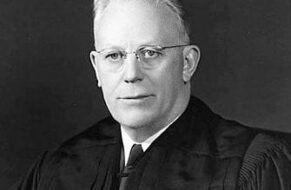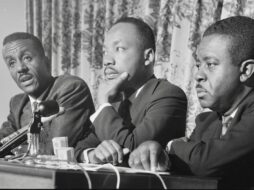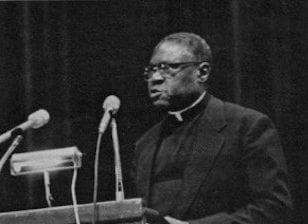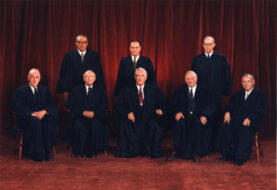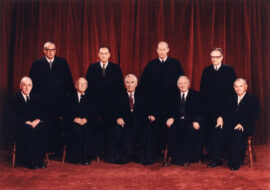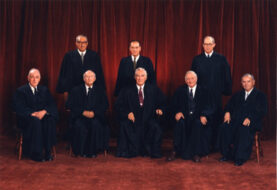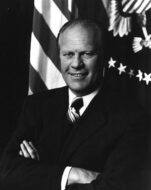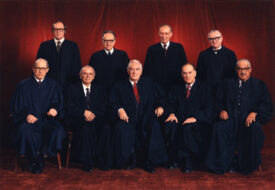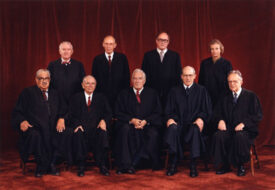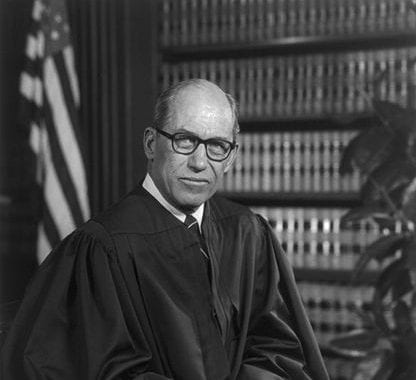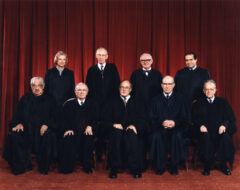

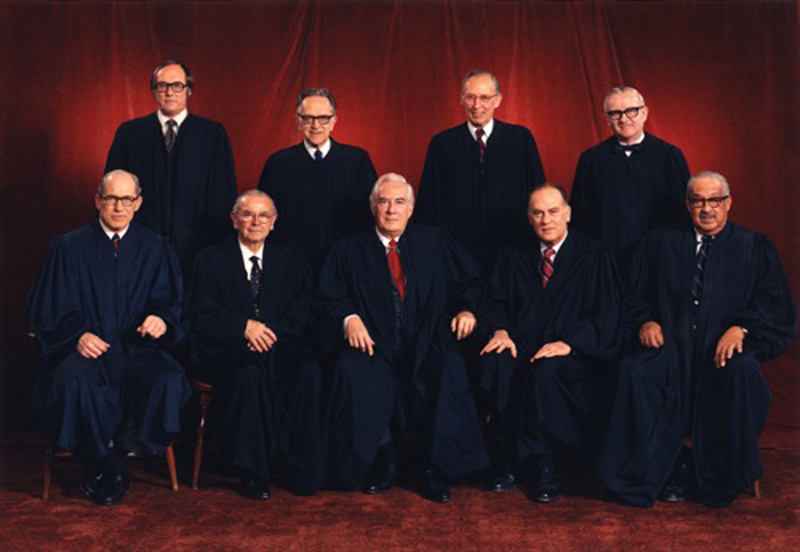
No related resources
Introduction
The Fourteenth Amendment declares that no state shall “deny to any person within its jurisdiction the equal protection of the laws.” In Brown v. Board of Education (1954), the Supreme Court held that racial segregation in public school violates the Equal Protection Clause. Ten years later Congress passed the Civil Rights Act; Title VI of the Act declares that “No person in the United States shall, on the ground of race, color, or national origin, be excluded from participation in, be denied the benefits of, or be subjected to discrimination under any program or activity receiving Federal financial assistance.” But neither Brown nor Title VI explicitly say whether states could employ race conscious admissions programs to remedy the effects of past discrimination.
The Medical School of the University of California at Davis opened in 1968 with an entering class of fifty students. In 1971, the size of the entering class was increased to one hundred students. No admissions program for disadvantaged or minority students existed when the school opened, and the first class contained three Asian students but no African Americans, Latinos, or American Indians . Over the next two years, the faculty devised a special admissions program to increase the representation of minority students in each Medical School class.
The special program consisted of a separate admissions system operating in coordination with the regular admissions process. On the application form, candidates were asked whether they wished to be considered as members of a “minority group,” which the Medical School described as “Blacks,” “Chicanos,” “Asians,” and “American Indians.” If these questions were answered affirmatively, the application was forwarded to the special admissions committee, which rated the applicants in a fashion similar to that used by the general admissions committee, except that special candidates did not have to meet the 2.5 grade point average cutoff applied to regular applicants. Sixteen of the one hundred seats in each incoming class of the Medical School were set aside for applicants from the special admissions system.
Allan Bakke was a white male who applied to the Davis Medical School in both 1973 and 1974. In both years Bakke’s application was considered under the general admissions program, and he received an interview. Despite a benchmark score of 468 out of 500 in 1973, Bakke was rejected. His application had come late in the year, and no applicants in the general admissions process with scores below 470 were accepted after Bakke’s application was completed. There were four special admissions slots unfilled at that time, however, for which Bakke was not considered. He applied again in 1974 and was rejected, even though applicants were admitted under the special program with grade point averages, MCAT scores, and benchmark scores significantly lower than Bakke’s. He then sued the Medical School for admission, arguing that its special admissions program operated to exclude him from the school on the basis of his race, in violation of his rights under the Fourteenth Amendment and Title VI. The trial court found that the special program violated the Federal Constitution and Title VI, but refused to order Bakke’s admission, on the ground that he had failed to carry his burden of proving that he would have been admitted but for the existence of the special program. Bakke appealed to the California Supreme Court, which ruled in his favor and ordered his admission to the Medical School. The school then appealed to the US Supreme Court, which handed down a split decision. With only Justice Lewis Powell signing the Opinion of the Court, it held by a 5-4 vote (Justices Powell, Stevens, Burger, Stewart, and Rehnquist) that the special admissions system violated Title VI and was therefore struck down (Justice Powell concluded that it also violated the Fourteenth Amendment). At the same time, however, the Court held by a different 5-4 vote (Justices Powell, Brennan, White, Marshall, and Blackmun) that neither Title VI nor the Fourteenth Amendment prohibited the Medical School from using race as one factor in admissions.
While Bakke decided the specific case and provided some guidance on which kinds of affirmative action programs would be permissible, the fractured opinions meant that it did not settle the issue. With changing personnel in the 1980s and 1990s, the Court voted in Adarand v. Pena (1995) to narrow the permissible use of race by demanding that it pass the strict scrutiny test, which requires government to have a compelling interest in using race and to use it as narrowly as possible. The Court then applied the strict scrutiny test to the use of race in college admissions in cases like Grutter v. Bollinger (2003), which explicitly endorsed (by a 5-4 vote) Justice Powell’s view that racial diversity is a compelling interest that permits a university to use race as one factor in admissions. Notwithstanding the Grutter decision, however, race conscious admissions programs remain constitutionally controversial.
Source: 438 U.S. 265; https://www.law.cornell.edu/supremecourt/text/438/265 For Justice Stevens’s opinion, see https://caselaw.findlaw.com/us-supreme-court/438/265.html#tt10
Justice POWELL announced the judgment of the Court.
. . . The guarantees of the Fourteenth Amendment extend to all persons. . . . The guarantee of equal protection cannot mean one thing when applied to one individual and something else when applied to a person of another color. If both are not accorded the same protection, then it is not equal. . . .
. . . Racial and ethnic distinctions of any sort are inherently suspect and thus call for the most exacting judicial examination.
This perception of racial and ethnic distinctions is rooted in our Nation’s constitutional and demographic history. The Court’s initial view of the Fourteenth Amendment was that its “one pervading purpose” was “the freedom of the slave race, the security and firm establishment of that freedom, and the protection of the newly-made freeman and citizen from the oppressions of those who had formerly exercised dominion over him” (Slaughter-House Cases [1873]). . . .
Although many of the Framers of the Fourteenth Amendment conceived of its primary function as bridging the vast distance between members of the Negro race and the white “majority,” the Amendment itself was framed in universal terms, without reference to color, ethnic origin, or condition of prior servitude. . . .
[The Medical School] urges us to . . . hold that discrimination against members of the white “majority” cannot be suspect if its purpose can be characterized as “benign.” The clock of our liberties, however, cannot be turned back to 1868.. It is far too late to argue that the guarantee of equal protection to all persons permits the recognition of special wards entitled to a degree of protection greater than that accorded others. . . .
Moreover, there are serious problems of justice connected with the idea of preference itself. First, it may not always be clear that a so-called preference is, in fact, benign. Courts may be asked to validate burdens imposed upon individual members of a particular group in order to advance the group’s general interest. . . . Second, preferential programs may only reinforce common stereotypes holding that certain groups are unable to achieve success without special protection based on a factor having no relationship to individual worth. Third, there is a measure of inequity in forcing innocent persons in [Bakke’s] position to bear the burdens of redressing grievances not of their making. . . .
If it is the individual who is entitled to judicial protection against classifications based upon his racial or ethnic background because such distinctions impinge upon personal rights, rather than the individual only because of his membership in a particular group, then constitutional standards may be applied consistently. Political judgments regarding the necessity for the particular classification may be weighed in the constitutional balance (Korematsu v. United States [1944]), but the standard of justification will remain constant. This is as it should be, since those political judgments are the product of rough compromise struck by contending groups within the democratic process. When they touch upon an individual’s race or ethnic background, he is entitled to a judicial determination that the burden he is asked to bear on that basis is precisely tailored to serve a compelling governmental interest. The Constitution guarantees that right to every person regardless of his background. . . .
We have held that in “order to justify the use of a suspect classification, a State must show that its purpose or interest is both constitutionally permissible and substantial, and that its use of the classification is ‘necessary . . . to the accomplishment’ of its purpose or the safeguarding of its interest” (Loving v. Virginia [1967]). The special admissions program purports to serve the purposes of: (i) “reducing the historic deficit of traditionally disfavored minorities in medical schools and in the medical profession”; (ii) countering the effects of societal discrimination; (iii) increasing the number of physicians who will practice in communities currently underserved; and (iv) obtaining the educational benefits that flow from an ethnically diverse student body. It is necessary to decide which, if any, of these purposes is substantial enough to support the use of a suspect classification.
If [the Medical School’s] purpose is to assure within its student body some specified percentage of a particular group merely because of its race or ethnic origin, such a preferential purpose must be rejected not as insubstantial, but as facially invalid. Preferring members of any one group for no reason other than race or ethnic origin is discrimination for its own sake. This the Constitution forbids (e. g., Brown v. Board of Education [1954]).
The State certainly has a legitimate and substantial interest in ameliorating, or eliminating where feasible, the disabling effects of identified discrimination. . . .
[But] we have never approved a classification that aids persons perceived as members of relatively victimized groups at the expense of other innocent individuals in the absence of judicial, legislative, or administrative findings of constitutional or statutory violations…. Without such findings of constitutional or statutory violations, it cannot be said that the government has any greater interest in helping one individual than in refraining from harming another. Thus, the government has no compelling justification for inflicting such harm. . . .
[The Medical School] identifies, as another purpose of its program, improving the delivery of health care services to communities currently underserved. It may be assumed that, in some situations, a State’s interest in facilitating the health care of its citizens is sufficiently compelling to support the use of a suspect classification. But there is virtually no evidence in the record indicating that [the Medical School]’s special admissions program is either needed or geared to promote that goal. . . .
[The Medical School] simply has not carried its burden of demonstrating that it must prefer members of particular ethnic groups over all other individuals in order to promote better health-care delivery to deprived citizens. Indeed, [the School] has not shown that its preferential classification is likely to have any significant effect on the problem.
The fourth goal asserted by [the Medical School]is the attainment of a diverse student body. This clearly is a constitutionally permissible goal for an institution of higher education. Academic freedom, though not a specifically enumerated constitutional right, long has been viewed as a special concern of the First Amendment. The freedom of a university to make its own judgments as to education includes the selection of its student body. . . .
Thus, in arguing that its universities must be accorded the right to select those students who will contribute the most to the “robust exchange of ideas,” [the Medical School] invokes a countervailing constitutional interest, that of the First Amendment. In this light, [the Medical School] must be viewed as seeking to achieve a goal that is of paramount importance in the fulfillment of its mission. . . .
. . . As the interest of diversity is compelling in the context of a university’s admissions program, the question remains whether the program’s racial classification is necessary to promote this interest.
It may be assumed that the reservation of a specified number of seats in each class for individuals from the preferred ethnic groups would contribute to the attainment of considerable ethnic diversity in the student body. But [the Medical School’s] argument that this is the only effective means of serving the interest of diversity is seriously flawed. . . . The diversity that furthers a compelling state interest encompasses a far broader array of qualifications and characteristics, of which racial or ethnic origin is but a single, though important, element. [The Medical School’s] special admissions program, focused solely on ethnic diversity, would hinder, rather than further, attainment of genuine diversity.
Nor would the state interest in genuine diversity be served by expanding [the Medical School’s] two-track system into a multi-track program with a prescribed number of seats set aside for each identifiable category of applicants. Indeed, it is inconceivable that a university would thus pursue the logic of [the Medical School’s] two-track program to the illogical end of insulating each category of applicants with certain desired qualifications from competition with all other applicants.
The experience of other university admissions programs, which take race into account in achieving the educational diversity valued by the First Amendment, demonstrates that the assignment of a fixed number of places to a minority group is not a necessary means toward that end. An illuminating example is found in the Harvard College program. . . .
In such an admissions program, race or ethnic background may be deemed a “plus” in a particular applicant’s file, yet it does not insulate the individual from comparison with all other candidates for the available seats. The file of a particular black applicant may be examined for his potential contribution to diversity without the factor of race being decisive when compared, for example, with that of an applicant identified as an Italian-American if the latter is thought to exhibit qualities more likely to promote beneficial educational pluralism. Such qualities could include exceptional personal talents, unique work or service experience, leadership potential, maturity, demonstrated compassion, a history of overcoming disadvantage, ability to communicate with the poor, or other qualifications deemed important. In short, an admissions program operated in this way is flexible enough to consider all pertinent elements of diversity in light of the particular qualifications of each applicant, and to place them on the same footing for consideration, although not necessarily according them the same weight. Indeed, the weight attributed to a particular quality may vary from year to year depending upon the “mix” both of the student body and the applicants for the incoming class.
This kind of program treats each applicant as an individual in the admissions process. The applicant who loses out on the last available seat to another candidate receiving a “plus” on the basis of ethnic background will not have been foreclosed from all consideration for that seat simply because he was not the right color or had the wrong surname. It would mean only that his combined qualifications, which may have included similar nonobjective factors, did not outweigh those of the other applicant. His qualifications would have been weighed fairly and competitively, and he would have no basis to complain of unequal treatment under the Fourteenth Amendment. . . .
In summary, it is evident that the Davis special admissions program involves the use of an explicit racial classification never before countenanced by this Court. It tells applicants who are not Negro, Asian, or Chicano that they are totally excluded from a specific percentage of the seats in an entering class. No matter how strong their qualifications, quantitative and extracurricular, including their own potential for contribution to educational diversity, they are never afforded the chance to compete with applicants from the preferred groups for the special admissions seats. At the same time, the preferred applicants have the opportunity to compete for every seat in the class.
The fatal flaw in [the Medical School’s] preferential program is its disregard of individual rights as guaranteed by the Fourteenth Amendment (Shelley v. Kraemer [1948]). Such rights are not absolute. But when a State’s distribution of benefits or imposition of burdens hinges on ancestry or the color of a person’s skin, that individual is entitled to a demonstration that the challenged classification is necessary to promote a substantial state interest. [The Medical School]has failed to carry this burden. For this reason, that portion of the California court’s judgment holding [the School’s] special admissions program invalid under the Fourteenth Amendment must be affirmed.
In enjoining [the Medical School] from ever considering the race of any applicant, however, the courts below failed to recognize that the State has a substantial interest that legitimately may be served by a properly devised admissions program involving the competitive consideration of race and ethnic origin. For this reason, so much of the California court’s judgment as enjoins [the Medical School] from any consideration of the race of any applicant must be reversed.
Opinion of Justices BRENNAN, WHITE, MARSHALL, and BLACKMUN, concurring in the judgment in part and dissenting in part.
. . . Our Nation was founded on the principle that “all Men are created equal.” Yet candor requires acknowledgment that the Framers of our Constitution, to forge the 13 Colonies into one Nation, openly compromised this principle of equality with its antithesis: slavery. The consequences of this compromise are well known, and have aptly been called our promise are well known and have aptly been called our “American Dilemma.” Still, it is well to recount how recent the time has been, if it has yet come, when the promise of our principles has flowered into the actuality of equal opportunity for all regardless of race or color.
The Fourteenth Amendment, the embodiment in the Constitution of our abiding belief in human equality, has been the law of our land for only slightly more than half its 200 years. And for half of that half, the Equal Protection Clause of the Amendment was largely moribund. . . . Worse than desuetude, the Clause was early turned against those whom it was intended to set free, condemning them to a “separate but equal” status before the law. . . . Not until 1954—only 24 years ago—was this odious doctrine interred by our decision in Brown v. Board of Education and its progeny. . . . Even then, inequality was not eliminated with “all deliberate speed” (Brown v. Board of Education II [1955]). . . . And a glance at our docket and at dockets of lower courts will show that, even today, officially sanctioned discrimination is not a thing of the past.
Against this background, claims that law must be “colorblind” or that the datum of race is no longer relevant to public policy must be seen as aspiration, rather than as description of reality. This is not to denigrate aspiration; for reality rebukes us that race has too often been used by those who would stigmatize and oppress minorities. Yet we cannot . . . let color blindness become myopia which masks the reality that many “created equal” have been treated within our lifetimes as inferior both by the law and by their fellow citizens. . . .
In our view, Title VI [of the Civil Rights Act] prohibits only those uses of racial criteria that would violate the Fourteenth Amendment if employed by a State or its agencies; it does not bar the preferential treatment of racial minorities as a means of remedying past societal discrimination to the extent that such action is consistent with the Fourteenth Amendment. . . . Congress [did not intend] to bar all race-conscious efforts to extend the benefits of federally financed programs to minorities who have been historically excluded from the full benefits of American life. . . .
[Bakke’s] contention that Congress intended Title VI to bar affirmative action programs designed to enable minorities disadvantaged by the effects of discrimination to participate in federally financed programs is also refuted by an examination of the type of conduct which Congress thought it was prohibiting by means of Title VI. The debates reveal that the legislation was motivated primarily by a desire to eradicate a very specific evil: federal financial support of programs which disadvantaged Negroes by excluding them from participation or providing them with separate facilities. . . .
Of course, it might be argued that the Congress which enacted Title VI understood the Constitution to require strict racial neutrality or color blindness, and then enshrined that concept as a rule of statutory law. . . . But there are three compelling reasons to reject such a hypothesis.
First, no decision of this Court has ever adopted the proposition that the Constitution must be colorblind.[1] . . . [The assertion of human equality is closely associated with the proposition that differences in color or creed, birth or status, are neither significant nor relevant to the way in which persons should be treated. Nonetheless, the position that such factors must be “constitutionally an irrelevance,” summed up by the shorthand phrase “[o]ur Constitution is color-blind” Plessy v. Ferguson has never been adopted by this Court as the proper meaning of the Equal Protection Clause. Indeed, we have expressly rejected this proposition on a number of occasions.]
Second, even if it could be argued in 1964 that the Constitution might conceivably require color blindness, . . . [i]t is inconceivable that Congress intended to encourage voluntary efforts to eliminate the evil of racial discrimination while at the same time forbidding the voluntary use of race-conscious remedies to cure acknowledged or obvious statutory violations. . . . It clearly desired to encourage all remedies, including the use of race, necessary to eliminate racial discrimination in violation of the Constitution, rather than requiring the recipient to await a judicial adjudication of unconstitutionality and the judicial imposition of a racially oriented remedy.
Third, the legislative history shows that Congress specifically eschewed any static definition of discrimination in favor of broad language that could be shaped by experience, administrative necessity, and evolving judicial doctrine. . . .
The explanation for this failure is clear. Specific definitions were undesirable, in the views of the legislation’s principal backers, because Title VI’s standard was that of the Constitution, and one that could and should be administratively and judicially applied. . . .
Congress’ resolve not to incorporate a static definition of discrimination into Title VI is not surprising. In 1963 and 1964, when Title VI was drafted and debated, the courts had only recently applied the Equal Protection Clause to strike down public racial discrimination in America, and the scope of that Clause’s nondiscrimination principle was in a state of flux and rapid evolution. Many questions, such as whether the Fourteenth Amendment barred only de jure discrimination or, in at least some circumstances, reached de facto discrimination, had not yet received an authoritative judicial resolution. The congressional debate reflects an awareness of the evolutionary change that constitutional law in the area of racial discrimination was undergoing in 1964. . . .
We conclude, therefore, that racial classifications are not per se invalid under the Fourteenth Amendment. Accordingly, we turn to the problem of articulating what our role should be in reviewing state action that expressly classifies by race. . . .
Unquestionably we have held that a government practice or statute which restricts “fundamental rights” or which contains “suspect classifications” is to be subjected to “strict scrutiny,” and can be justified only if it furthers a compelling government purpose and, even then, only if no less restrictive alternative is available. But no fundamental right is involved here. Nor do whites, as a class, have any of the “traditional indicia of suspectness: the class is not saddled with such disabilities, or subjected to such a history of purposeful unequal treatment, or relegated to such a position of political powerlessness as to command extraordinary protection from the majoritarian political process” (United States v. Carolene Products Co, note 4 [1938]).
Moreover, . . . this is not a case where racial classifications are “irrelevant and therefore prohibited.” Nor has anyone suggested that the University’s purposes contravene the cardinal principle that racial classifications that stigmatize—because they are drawn on the presumption that one race is inferior to another or because they put the weight of government behind racial hatred and separatism—are invalid. . . .
. . . Instead, . . . racial classifications designed to further remedial purposes “must serve important governmental objectives and must be substantially related to achievement of those objectives” ( . . .
Davis’ articulated purpose of remedying the effects of past societal discrimination is . . . sufficiently important to justify the use of race-conscious admissions programs where there is a sound basis for concluding that minority underrepresentation is substantial and chronic, and that the handicap of past discrimination is impeding access of minorities to the Medical School. . . .
Properly construed, therefore, our prior cases unequivocally show that a state government may adopt race-conscious programs if the purpose of such programs is to remove the disparate racial impact its actions might otherwise have, and if there is reason to believe that the disparate impact is itself the product of past discrimination, whether its own or that of society at large. There is no question that Davis’ program is valid under this test. . . .
Moreover, we need not rest solely on our own conclusion that Davis had sound reason to believe that the effects of past discrimination were handicapping minority applicants to the Medical School, because the Department of Health, Education, and Welfare, the expert agency charged by Congress with promulgating regulations enforcing Title VI of the Civil Rights Act of 1964, has also reached the conclusion that race may be taken into account in situations where a failure to do so would limit participation by minorities in federally funded programs, and regulations promulgated by the Department expressly contemplate that appropriate race-conscious programs may be adopted by universities to remedy unequal access to university programs caused by their own or by past societal discrimination. . . .
The second prong of our test—whether the Davis program stigmatizes any discrete group or individual and whether race is reasonably used in light of the program’s objectives—is clearly satisfied by the Davis program. . . .
. . . True, whites are excluded from participation in the special admissions program, but this fact only operates to reduce the number of whites to be admitted in the regular admissions program in order to permit admission of a reasonable percentage—less than their proportion of the California population—of otherwise underrepresented qualified minority applicants.
Nor was Bakke in any sense stamped as inferior by the Medical School’s rejection of him. Indeed, it is conceded by all that he satisfied those criteria regarded by the school as generally relevant to academic performance better than most of the minority members who were admitted. Moreover, there is absolutely no basis for concluding that Bakke’s rejection as a result of Davis’ use of racial preference will affect him throughout his life in the same way as the segregation of the Negro school children in Brown I would have affected them. Unlike discrimination against racial minorities, the use of racial preferences for remedial purposes does not inflict a pervasive injury upon individual whites in the sense that, wherever they go or whatever they do, there is a significant likelihood that they will be treated as second-class citizens because of their color. This distinction does not mean that the exclusion of a white resulting from the preferential use of race is not sufficiently serious to require justification; but it does mean that the injury inflicted by such a policy is not distinguishable from disadvantages caused by a wide range of government actions, none of which has ever been thought impermissible for that reason alone.
In addition, there is simply no evidence that the Davis program discriminates intentionally or unintentionally against any minority group which it purports to benefit . . . [by] stigmatizing the program’s beneficiaries or their race as inferior. The Davis program does not simply advance less qualified applicants; rather, it compensates applicants, who it is uncontested are fully qualified to study medicine, for educational disadvantages which it was reasonable to conclude were a product of state-fostered discrimination. Once admitted, these students must satisfy the same degree requirements as regularly admitted students; they are taught by the same faculty in the same classes; and their performance is evaluated by the same standards by which regularly admitted students are judged. Under these circumstances, their performance and degrees must be regarded equally with the regularly admitted students with whom they compete for standing. Since minority graduates cannot justifiably be regarded as less well qualified than nonminority graduates by virtue of the special admissions program, there is no reasonable basis to conclude that minority graduates at schools using such programs would be stigmatized as inferior by the existence of such programs. . . .
Accordingly, we would reverse the judgment of the Supreme Court of California holding the Medical School’s special admissions program unconstitutional and directing [Bakke’s] admission, as well as that portion of the judgment enjoining the Medical School from according any consideration to race in the admissions process.
Justice MARSHALL, concurring in part and dissenting in part.
I agree with the judgment of the Court only insofar as it permits a university to consider the race of an applicant in making admissions decisions. I do not agree that [the Davis] admissions program violates the Constitution. For it must be remembered that, during most of the past 200 years, the Constitution, as interpreted by this Court, did not prohibit the most ingenious and pervasive forms of discrimination against the Negro. Now, when a state acts to remedy the effects of that legacy of discrimination, I cannot believe that this same Constitution stands as a barrier. . . .
. . . The position of the Negro today in America is the tragic but inevitable consequence of centuries of unequal treatment. Measured by any benchmark of comfort or achievement, meaningful equality remains a distant dream for the Negro. . . .
I do not believe that the Fourteenth Amendment requires us to accept that fate. Neither its history nor our past cases lend any support to the conclusion that a university may not remedy the cumulative effects of society’s discrimination by giving consideration to race in an effort to increase the number and percentage of Negro doctors. . . .
Justice STEVENS, concurring in the judgment in part and dissenting in part, joined by Chief Justice BURGER and Justices STEWART and REHNQUIST.
Both [the Medical School] and [Bakke] have asked us to determine the legality of the University’s special admissions program by reference to the Constitution. Our settled practice, however, is to avoid the decision of a constitutional issue if a case can be fairly decided on a statutory ground. . . . Only if [the Medical School] should prevail on the statutory issue would it be necessary to decide whether the University’s admissions program violated the Equal Protection Clause of the Fourteenth Amendment.
Section 601 I of the Civil Rights Act of 1964 . . . provides:
“No person in the United States shall, on the ground of race, color, or national origin, be excluded from participation in, be denied the benefits of, or be subjected to discrimination under any program or activity receiving Federal financial assistance.”
The University, through its special admissions policy, excluded Bakke from participation in its program of medical education because of his race. The University also acknowledges that it was, and still is, receiving federal financial assistance. The plain language of the statute therefore requires affirmance of the judgment below. A different result cannot be justified unless that language misstates the actual intent of the Congress that enacted the statute or the statute is not enforceable in a private action. Neither conclusion is warranted.
Title VI is an integral part of the far-reaching Civil Rights Act of 1964. No doubt, when this legislation was being debated, Congress was not directly concerned with the legality of “reverse discrimination” or “affirmative action” programs. Its attention was focused on the problem at hand, the “glaring . . . discrimination against Negroes which exists throughout our Nation,”[2] and, with respect to Title VI, the federal funding of segregated facilities. The genesis of the legislation, however, did not limit the breadth of the solution adopted. Just as Congress responded to the problem of employment discrimination by enacting a provision that protects all races so, too, its answer to the problem of federally funding of segregated facilities stands as a broad prohibition against the exclusion of any individual from a federally funded program “on the ground of race.” . . .
[The Medical School] contends, however, that exclusion of applicants on the basis of race does not violate Title VI if the exclusion carries with it no racial stigma. No such qualification or limitation of 601’s categorical prohibition of “exclusion” is justified by the statute or its history. The language of the entire section is perfectly clear; the words that follow “excluded from” do not modify or qualify the explicit outlawing of any exclusion on the stated grounds. . . .
The University’s special admissions program violated Title VI of the Civil Rights Act of 1964 by excluding Bakke from the Medical School because of his race. It is therefore our duty to affirm the judgment ordering Bakke admitted to the University.
Accordingly, I concur in the Court’s judgment insofar as it affirms the judgment of the Supreme Court of California. To the extent that it purports to do anything else, I respectfully dissent.

Conversation-based seminars for collegial PD, one-day and multi-day seminars, graduate credit seminars (MA degree), online and in-person.






